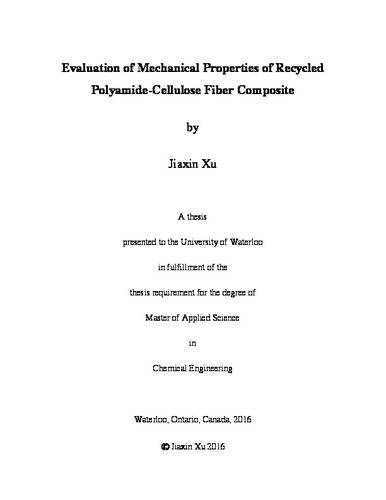| dc.contributor.author | Xu, Jiaxin | |
| dc.date.accessioned | 2016-09-21 17:42:20 (GMT) | |
| dc.date.available | 2016-09-21 17:42:20 (GMT) | |
| dc.date.issued | 2016-09-21 | |
| dc.date.submitted | 2016-09-19 | |
| dc.identifier.uri | http://hdl.handle.net/10012/10884 | |
| dc.description.abstract | Natural fiber as an alternative for glass fiber to reinforce thermoplastic in the automotive industry has already attracted many manufacturers’ interest because of its many benefits. Natural fiber is biodegradable, has high modulus, low density, low cost and can be obtained from many natural resources. Thermoplastic composites of polyamide 6 (PA6) and cellulose from wood fiber can improve the modulus of PA6 and reduce the weight of an automotive component when compared to glass fiber. However, there is a challenge associated with the thermal stability of cellulose. Therefore one research challenge to processing PA6 with natural fibers is thermal degradation. High processing temperature, mechanical forces and oxygen environment can cause PA6 thermal-oxidation as well. Since the lifetime of automotive parts are closely related to the oxidation behavior of PA6, it is necessary to understand the oxidation mechanism and to find suitable antioxidants for PA6/cellulose composite.
The objective of this thesis is to evaluate appropriate levels of primary antioxidant Irganox 1010 and secondary antioxidant Irgafox 168 for such composites. Mechanical properties, thermal characteristics, crystallinity and morphology were measured to correlate with the antioxidant effectiveness. The effect of cellulose added to the composite was also evaluated. It was observed that 500 ppm of Irganox 1010 may be the best amount needed due to its increase of tensile modulus by 21.99% and its increase of flexural modulus by 8.75%. While the addition of Irgafox 168 combined with Irganox 1010 did not add improvement among different formulations.
The oxidation induction time (OIT) test is considered a good method to detect the antioxidant performance and help to find appropriate antioxidant for other polymers (such as polyethylene). However, the OIT procedure was not well established for PA6 as the test showed its ineffectiveness to evaluate thermal stability of polyamide. Alternative methodologies to evaluate thermal stability have shown to be more suitable than OIT. Thermal gravimetric analysis was successfully used to measure thermal stability at constant (isothermal) temperatures. | en |
| dc.language.iso | en | en |
| dc.publisher | University of Waterloo | en |
| dc.subject | reinforcement of PA6 with cellulose | en |
| dc.title | Evaluation of Mechanical Properties of Recycled Polyamide-Cellulose Fiber Composite | en |
| dc.type | Master Thesis | en |
| dc.pending | false | |
| uws-etd.degree.department | Chemical Engineering | en |
| uws-etd.degree.discipline | Chemical Engineering | en |
| uws-etd.degree.grantor | University of Waterloo | en |
| uws-etd.degree | Master of Applied Science | en |
| uws.contributor.advisor | Leonardo, Simon | |
| uws.contributor.affiliation1 | Faculty of Engineering | en |
| uws.published.city | Waterloo | en |
| uws.published.country | Canada | en |
| uws.published.province | Ontario | en |
| uws.typeOfResource | Text | en |
| uws.peerReviewStatus | Unreviewed | en |
| uws.scholarLevel | Graduate | en |

